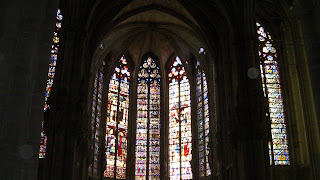Carcassonne is a city in the Languedoc region of France, about 3 hours from the villa in Venelles. Carcassonne is famous for it's upper walled city, simply called La Cite. The upper fortified portion of the city, founded by the Visigoths, dates from about the 5th century. Much of the attraction of the La Cite is due to heavy restoration in the mid 1850's. As many road signs remind you, this is Cathar Country, where the battles and sieges of the catholic church's crusade against the Cathars happened. Carcassonne was a Cathar stronghold up until 1209 when the crusaders took the city.
Our first view of La Cite, perched on the hill. The double tower to the left is the drawbridge gate, the only entrance to the old city. The "witches hat" tile roofs on the towers are part of the restorations done in the 1800's the originals would have been wood.
On the drawbridge.
All told there are 53 towers, one of which housed the Catholic inquisition of the 13th century.
Someone needs to tell this horse that mohawks went out in the 80's
The design of the fortified city is a double walled battlement, with a dry ditch in the centre. This prevents attackers using siege engines to scale the walls.
One of the village squares, specifically where we ate the first night. This is place marcou, which when the weather is nice turns into one giant outdoor bistro. The speciality of the region is cassoulet, a dish which in it's base description is "pork and beans". However like most things French, this dish has been raised to the pinnacle of pork and beans, forget it Heinz you have no hope. The cassoulet of Carcassonne usually has the addition of duck (confit) to the ubiquitous pork sausage (in this region Toulouse sausage) and white beans.
View of the basilica of Saint-Nazaire approaching from the back. This section of the basilica is gothic -- see those pointed arches, with large stained glass windows. The front of the basilica is older, and is romanesque, with round arches, and small windows.
There are two rose windows in the North and South transepts. This is the North end window, the South end one is out of focus.
Windows behind the main altar.
Interesting over-hung building in the old city ... of course its a restaurant, and yup, it has cassoulet.
but..there are other things to eat in Carcassonne...these are disturbing marzipans.
The gate and bridge to the castle of Carcassonne... the Chateau Comtal. This is a very rare picture of Carcassonne as there are only 2 people in it. In the summer Carcassonne is to be avoided as that is when most of the 4 million visitors arrive.
view back to the basilica from the chateau. This gives you a feeling for the scope of the old city, all this is within the fortified walls.
Kind of says it all, although they need a similar sign on the outside of the gates, "Cite du Cassoulet"
The walls at night.
Believe it or not there is more to Carcassonne than the old fortified city, there are actually people living here and restaurants with something to offer other than cassoulet. Below is a section of the Canal du Midi, which runs from the Atlantic Ocean to the Mediterranean sea. The canal was built in the mid 1600s as a short cut from the Atlantic to the Med, that also bypassed Spain and the areas plagued by Barbary pirates.
Farewell Carcassonne.
The oldest thing in this picture is indeed the Roman era aqueduct in the background. This is Pont du Gard, the tallest Roman aqueduct in the world at 160 feet. It was part of an aqueduct system bringing water from Uze to the city of Nimes. Our post on Nimes the aqueduct ran 50km, and brought and estimated 200 million litres of water per day to Nimes.
The aqueduct riding off into the future, ...interesting to remember that these constructions were here long before we were, and will be here long after we aren't.



















No comments:
Post a Comment